Here’s everything you need to know about using buckwheat in your kitchen, from milling buckwheat flour to sprouting buckwheat groats… plus lots of buckwheat recipes!
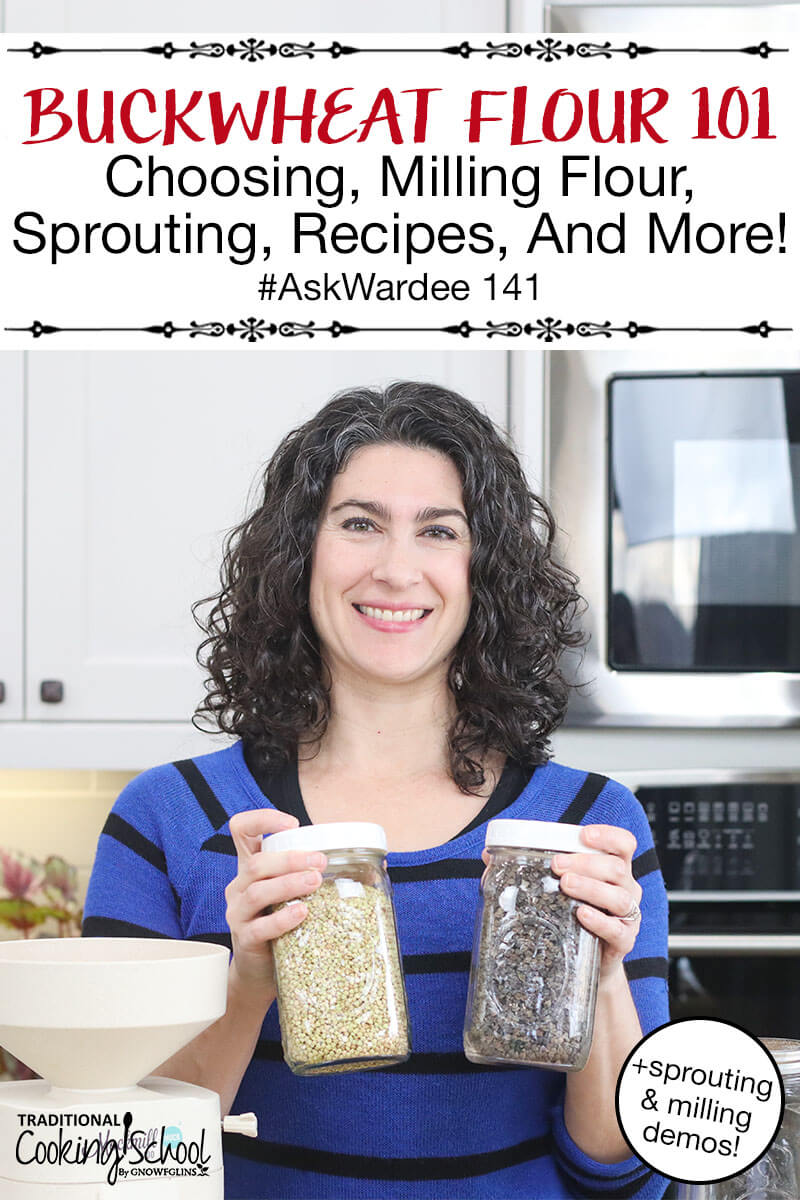
“Is buckwheat a good choice for gluten-free baking and for milling in the Mockmill? What buckwheat recipes do you recommend and where can I buy it?” asks Kathy.
Kathy, buckwheat is a GREAT choice for gluten-free baking and for milling in the Mockmill. It’s also wonderful to sprout (with a caveat) and there’s just so much to love about buckwheat.
And I’m covering it all on today’s #AskWardee. Keep reading or watching below to learn more!
Subscribe to #AskWardee on iTunes, Stitcher, YouTube, or the Podcasts app.
Table Of Contents
The Question: Tell Me More About Buckwheat Milling, Sprouting & Recipes!
Kathy asked:
Hi Wardee, I have a few questions about buckwheat seed.
1. Is this a good seed for grinding in the Mockmill?
2. Does it need to be pre-soaked?
3. Is sprouting it a good choice?
4. Do you have a company you recommend purchasing buckwheat from?
5. Have you used this seed, and do you have any gluten-free buckwheat recipes?”—Kathy
Kathy, thank you for your question!
Because we’re featuring your question today’s #AskWardee, you’re getting a gift — a FREE eBook and Video Package! Our team will be in contact with you so you can choose which one you’d like!
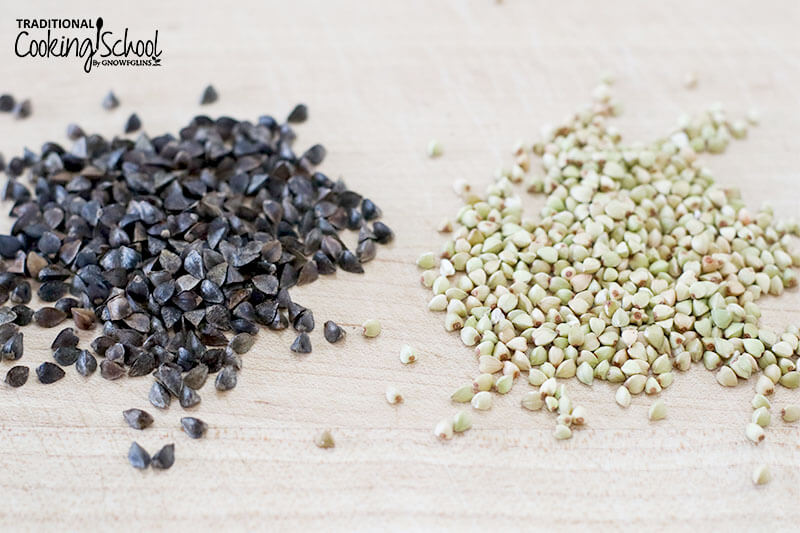
#1 — Can you grind buckwheat flour in the Mockmill?
Yes, it’s a wonderful choice for making your own flour! And the Mockmill does a fabulous job making buckwheat flour.
There are two kinds of buckwheat seed you can buy. One with the dark brown hull still on that’s often called whole buckwheat or sprouting buckwheat. And another with the hull removed that’s called buckwheat groats or “hulled” buckwheat.
It’s really confusing! Does “hulled” mean the hull is on or off??? You just have to remember it’s off, because the name is just plain confusing and could go either way. 😉
The buckwheat with the hull still on is dark brown, while the “hulled” buckwheat groats (where the hull has been removed), is like a grey-greenish color. They are both somewhat geometric in shape.
Either can be milled in the Mockmill. The buckwheat with hull turns into a flour with dark flecks, while the “hulled” buckwheat (no hull) turns out a lighter greyish color.
The buckwheat with hull makes a heavier flour for baking.
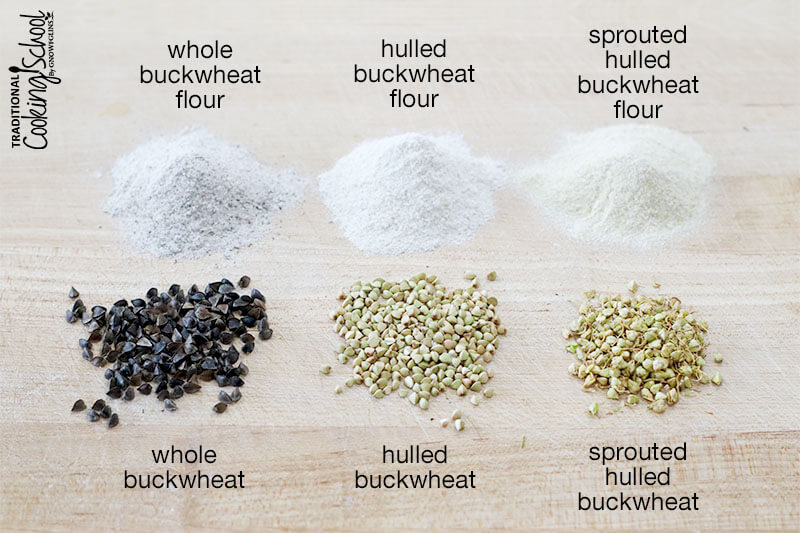
How to grind buckwheat into sprouted flour
My recommendation for the best home grain mill is the Mockmill. It’s affordable, convenient, easy to use, and makes really nice fine flour.
And you can get free gifts from me if you purchase using my link (required) for a limited time, right here. See below for more info including how to get an extra bonus from me.
Put a bowl below the flour shoot. Turn the Mockmill on.
Put buckwheat (unhulled or hulled) in hopper. Turn off Mockmill when the buckwheat is all ground into flour.
If milling unhulled buckwheat, you might notice the hull pops off and comes through the mill as little sheets along with the flour. So, for best results, also sift the unhulled buckwheat to sift out the hull pieces.
Use the flour within 24 hours, or store in fridge or freezer in an air-tight container to preserve freshness.
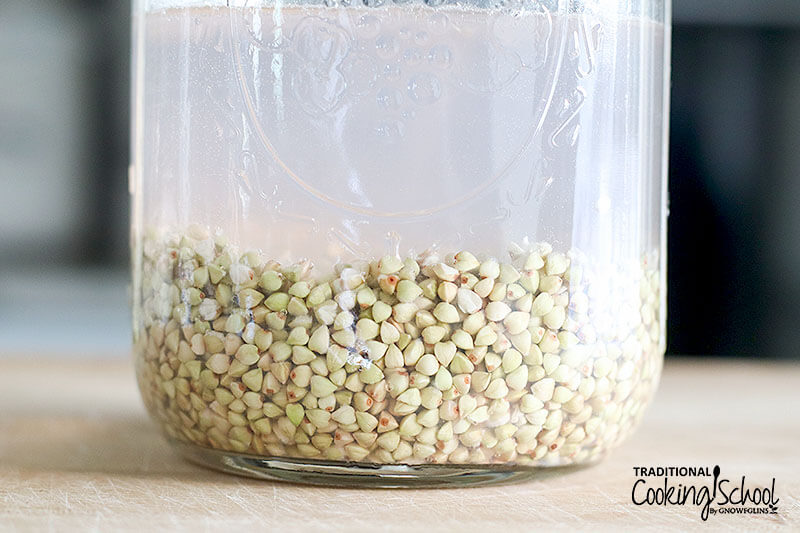
#2 — Does buckwheat need to be pre-soaked?
Soaking is always beneficial with seeds.
However, the “hulled” buckwheat (hull removed) is a little peculiar in that it gets gummy, really fast. So you soak for just 5 minutes or so.
So with this buckwheat, or even with the buckwheat that still has its hull, it’s best to grind it into flour, THEN use in a recipe with a soaking stage. It’s less time intensive this way (as opposed to soaking, then dehydrating, then milling).
However, if you’re making a sprouted buckwheat crunchy breakfast cereal, do soak for 20 to 30 minutes (but only that), then move on to sprout and dehydrate.
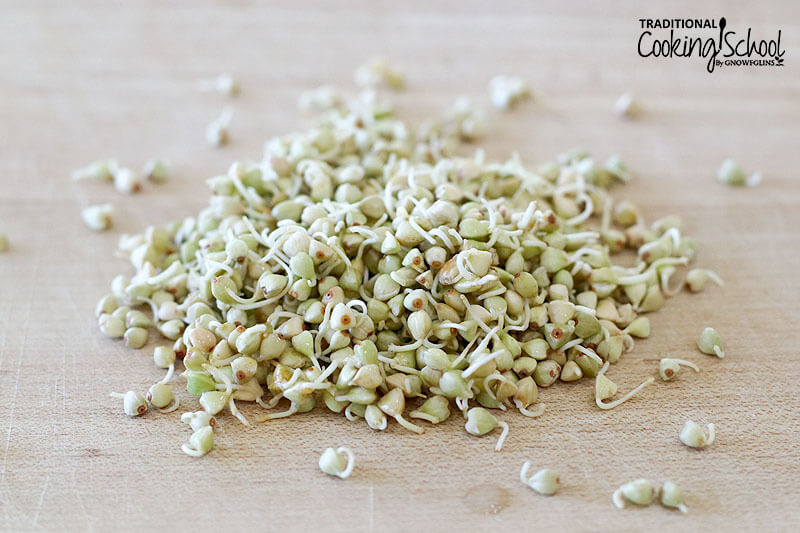
#3 — Is sprouting a good idea with buckwheat?
Yes, with a caveat!
Because buckwheat is a “seed” — just like wheat, rice, quinoa, or any other grain or pseudo-grain — it contains anti-nutrients like phytic acid and lectins. These can lead to nutritional deficiencies and more.
Since the methods of soaking, sprouting, and souring reduce anti-nutrients, you should use these methods on buckwheat, too. You’ll make buckwheat more nutritious and digestible… and actually more delicious, too!
Both kinds of buckwheat sprout well. In fact, buckwheat is one of the fastest seeds to sprout!
However, I recommend sprouting only the hulled buckwheat.
Even though people often soak (overnight), then sprout buckwheat (with hull) to make their own buckwheat microgreens, and even we used to do this, I no longer recommend it due to concerns about it causing phototoxicity.
According to Gilles Arbour…
The basic problem with buckwheat greens is that they contain fagopyrin, a naturally occurring substance in the buckwheat plant. When ingested in sufficient quantity, fagopyrin is known to cause the skin of animals and people to become phototoxic, which is to say hypersensitive to sunlight.
This condition, specifically known as fagopyrism, occurs when the ingested fagopyrin accumulates under the skin and is subsequently activated by sunlight, resulting in a toxic reaction within the skin. Typically, exposed areas of skin turn pink or red within minutes, and a strong burning sensation accompanies the reaction. Within a few hours the exposed areas usually appear to return to normal, however continue to remain ultra-sensitive to cold water, hot water and to friction. This sensitivity can last for days.
In addition to the burning sensation, people suffering from fagopyrism often complain of feeling a numb, fuzzy, buzzing impression when they scratch or inadvertently hit their hands on something. Sufferers also report that their hands feel painfully cold when placed in cold water or when in contact with a cold object, even if only for a few seconds. Some have had numbing, itching and tickling on the face, nose and ears after sun exposure causing a desire to scratch the skin, thus worsening the condition. The eyes may also become hypersensitive to light. If a large enough portion of the skin is exposed, one may experience dizziness. If a person is forced to remain in the sun for a long period of time, the skin may swell up and remain abnormal for up to several days. (Source.)
On the other hand, we still do love to sprout hulled buckwheat for recipes like my cold breakfast cereal (see below)… but stop the sprouting before any green leaves appear!
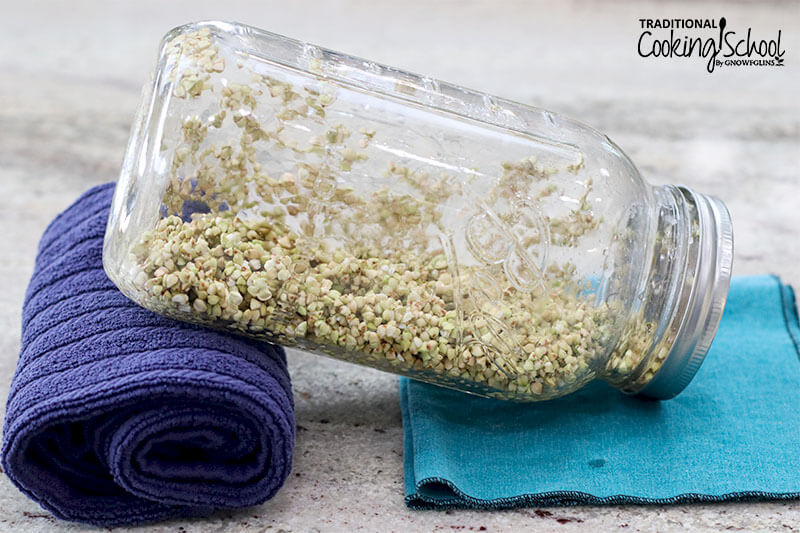
How to sprout hulled buckwheat groats
Soak 1 cup of hulled buckwheat groats for 20 to 30 minutes in a half gallon jar.
Put a sprouting lid on the top of the jar, then drain and rinse.
Rinse and drain twice daily as you allow the buckwheat to sprout (about 18 to 48 hours). Keep the jar tipped slightly downward to allow excess water to drain.
When done sprouting, store in the fridge to slow down the sprouting, but do consume within a few days.
It makes a delicious cold cereal! If your digestive system is up for eating them raw, just add honey or maple syrup, cinnamon, and your choice of milk. Yumm!
Or else, dehydrate as follows…
How to dehydrate sprouted hulled buckwheat groats
Spread just rinsed and drained buckwheat sprouts in a thin layer on a lined dehydrator tray. Dry at 115 degrees Fahrenheit until dry, about 24 hours.
How to grind sprouted buckwheat into sprouted flour
My recommendation for the best home grain mill is the Mockmill. It’s affordable, convenient, easy to use, and makes really nice fine flour.
Put a bowl below the flour shoot. Turn the Mockmill on.
Put dried, sprouted buckwheat groats in hopper. Turn off Mockmill when the buckwheat is all ground into flour. You may have to help it along a bit as the sprout tails slow down the grinding.
Use the flour within 24 hours, or store in fridge or freezer in an air-tight container to preserve freshness.
Get free gifts from me with your purchase of the Mockmill for a limited time right here! More information (including a special bonus from me) is below.
#4 — Where to purchase buckwheat?
It’s important to get organic buckwheat. Additionally, if you plan to sprout it, it’s helpful to look for “sprouting” seed quality.
In the past, I have ordered buckwheat through Azure Standard. There are suppliers on Amazon as well.
Here is the organic “sprouting” quality buckwheat I just purchased to demo in this episode.
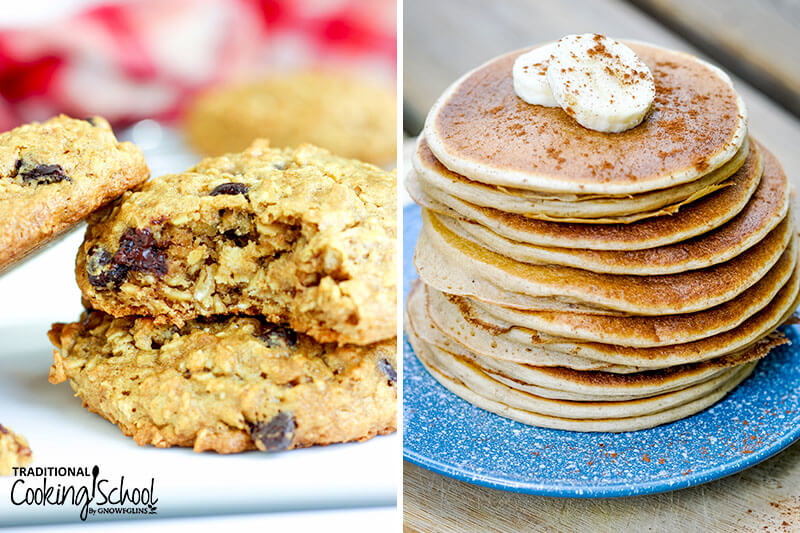
#5 — Have you used buckwheat, and do you have any gluten-free buckwheat recipes?
First of all, I want to plainly answer the related question for everyone’s benefit: does buckwheat contain gluten or even wheat?
No, it doesn’t. Even though “wheat” is the name, it contains no wheat flour… or gluten.
This makes it a great choice for gluten-free baking!
When my daughter had a gluten sensitivity years ago, I used both kinds of buckwheat in our kitchen.
We grew buckwheat microgreens (though I don’t recommend this anymore), we made sprouted buckwheat groat cold cereal both “wet” and dehydrated, and I used buckwheat flour (both kinds) in homemade soaked gluten-free baked goods.
In a gluten-free flour blend, I prefer to use buckwheat as just one of the 4 or 5 flours that are in the blend. With gluten-free baking, a blend usually always performs better in baked goods than a single flour does.
Here are some buckwheat recipes for you:
- Sprouted Buckwheat Breakfast Cereal
- Blender Banana Oatmeal Pancakes
- Soaked Gluten-Free Blender Waffles
- Healthy Chocolate Chip Breakfast Cookies
- Overnight Chocolate Baked Oatmeal (easy back-to-school breakfast)
- Search “buckwheat” on Traditional Cooking School
The buckwheat recipes linked above use traditional methods and if you’d like an easy video introduction to traditional cooking methods, be sure to sign up for our free Traditional Cooking Video Series right here. You’ll also get 15+ free eBooks!
My Favorite Grain Mill: The Mockmill
The Mockmill is my favorite grain mill and the one I recommend! I’ve been recommending it for a while now and lots of you have already gotten one in your homes. Mockmill tells me you’re very happy and I’m glad about that. 🙂
The Mockmill is a home stone grain mill, and it’s engineered and manufactured in Germany by Wolfgang Mock. He started making home grain mills back in the 1970s, so he’s been doing it for over 40 years. It’s estimated that nearly 70% of the stone mills out there are made by him.
This mill is super exciting because it contains the best features of Wolfgang Mock’s milling career, yet it’s much more affordable. The reason it’s more affordable is because this mill comes in a durable recycled material housing (instead of expensive wood).
I love the Mockmill because it produces super healthy freshly-ground flour with a really fine texture. It doesn’t warm the flour up like some mills do, so the flour is more nutritious. Finally, the flour yields wonderful, light bread!
This mill will also grind all grains, even gluten-free. It can even crack grains for porridge, and it has many other uses (like some spices, nuts, and seeds).
All the details — including a special gift from me — are on this page. By the way, it also comes as a KitchenAid attachment — very exciting for those who don’t want another appliance to take up any more room!
And, for a limited time… if you decide to purchase the Mockmill with my link (required), I’m ALSO throwing in complimentary copies of both my Sourdough A to Z and Einkorn Baking eBook and Video Packages. They’re each worth $64 for a total of $128 in additional bonuses from me.
To claim your extra free bonuses from me after purchasing the Mockmill using my link (required), just go to tradcookschool.com/millbonus. Have your order # handy, because you’ll need it to claim the two free eBook packages!
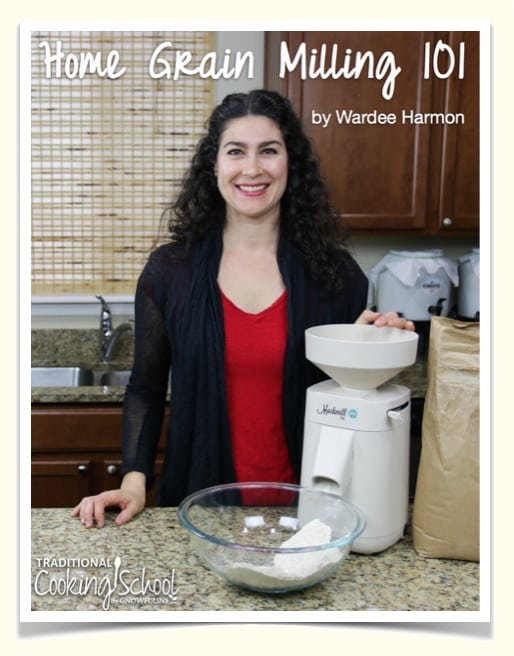 Want our FREE “Home Grain Milling 101” eBook? Click here to download the “Home Grain Milling 101” eBook for FREE!
Want our FREE “Home Grain Milling 101” eBook? Click here to download the “Home Grain Milling 101” eBook for FREE!
Any Questions Or Comments?
If you have other questions or comments about your own experiences with buckwheat, be sure to leave them in the comments!
Helpful Links
- How Long Do Sprouted Grains Last? #AskWardee 136
- The Mockmill —my favorite and recommended (affordable) home stone grain mill — Hurry! Get free gifts from me for a limited time!
- Claim your FREE ($128 value) bonuses from me with your purchase of the Mockmill using my link (required)
- Free “Home Grain Milling 101” eBook — our entire 4-part series combined into a single, FREE download from me!
- The Basics: Home Grain Milling 101 (Part 1)
- Milling Gluten-Free Grains Into Flour: Home Grain Milling 101 (Part 2)
- Baking With Fresh Ground Flour: Home Grain Milling 101 (Part 3)
- More Fun Things Your Grain Mill Can Do: Home Grain Milling 101 (Part 4)
- How to Store Flour & Grains
- Do Sprouting, Culturing, Or Sourdough Reduce Carbs? AW905
- Hulled buckwheat groats, organic, sprouting
- Unhulled buckwheat, organic, sprouting
- sprouting lid
- Sprouted Buckwheat Breakfast
- Blender Banana Oatmeal Pancakes
- Soaked Gluten-Free Blender Waffles
- Healthy Chocolate Chip Breakfast Cookies
- Search “buckwheat” on Traditional Cooking School
More Mockmill Related Articles from the #AskWardee Show:
- Unboxing The Mockmill (Affordable Home Stone Grain Mill)
- Differences Between Nutrimill And Mockmill #AskWardee 120
- How To Simply & Easily Clean Your Mockmill Grain Mill #AskWardee 119
- Where To Buy Whole Wheat Berries, Grains, and Flour #AskWardee 148
- How to Mill Flour at Home: Home Grain Milling 101
- Milling Soft Wheat In A Grain Mill {Homemade Pastry Flour} #AskWardee 131
- Is The New Ultragrain White Whole Wheat Healthy? #AskWardee 112
Do you bake with buckwheat flour? Which type do you use? What are your favorite recipes or ways to use buckwheat?
...without giving up the foods you love or spending all day in the kitchen!

2 free books:
Eat God's Way
Ditch the Standard American Diet, get healthier & happier, and save money on groceries...
We only recommend products and services we wholeheartedly endorse. This post may contain special links through which we earn a small commission if you make a purchase (though your price is the same).




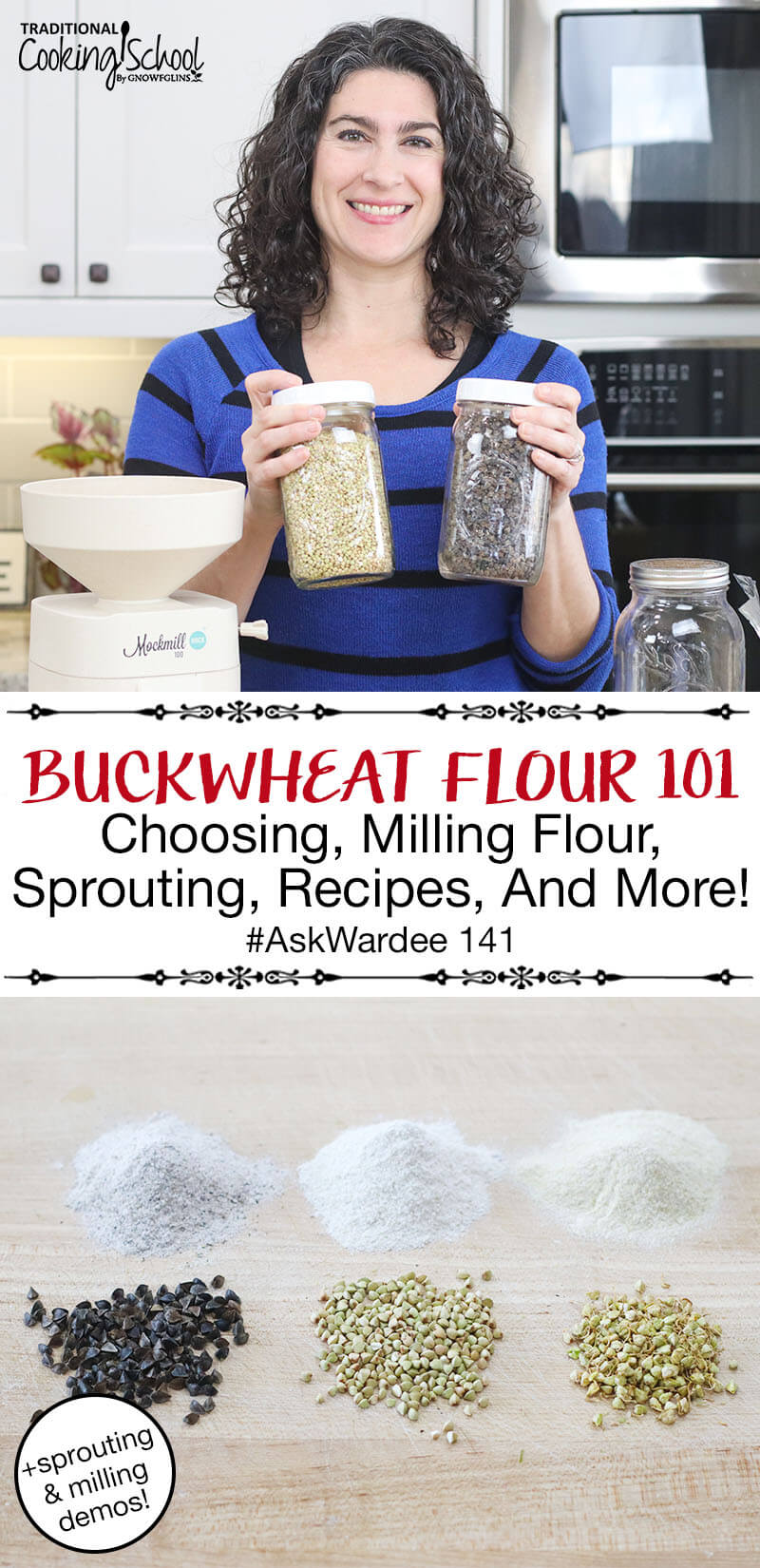
I have tried buckwheat flour before, but I do NOT like the flavor/taste much – may be I need to try the groats and see how strong that is flavorwise. Not one of my preferred grains 🙂
Gudrun, I know what you mean and that’s actually why I like blending it with other flours in baking rather than using it 100%. Also, for baking, I prefer flour from the groats rather than the sprouting buckwheat, because the “white” buckwheat flour has a milder taste. Thanks for your comment!